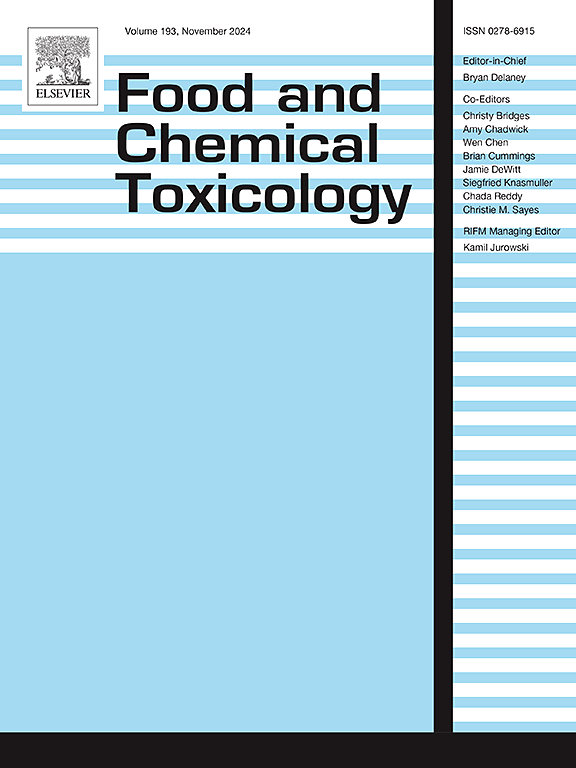Loperamide-induced constipation is associated with excessive accumulation of bile acids and cholesterol in the liver of mice; attenuation by hesperidin
IF 3.9
3区 医学
Q2 FOOD SCIENCE & TECHNOLOGY
引用次数: 0
Abstract
Loperamide, a widely used antidiarrheal agent, frequently induces constipation alongside other adverse effects. This study explored hesperidin's therapeutic potential in alleviating loperamide-induced constipation and its underlying mechanisms. Constipation models were established in HFD- or NFD-fed mice via loperamide administration (5 mg/kg/day). Hesperidin (100 mg/kg/day) significantly increased fecal weight and moisture in constipated mice. Biochemical analyses revealed elevated cholic acid/chenodeoxycholic acid ratios in serum and liver tissues of loperamide-treated HFD mice, indicating bile acids dysregulation. qRT-PCR and Western blot results demonstrated that hesperidin downregulated hepatic expression of cholesterol/bile acids biosynthesis genes (e.g., Hmgcr, Cyp7a1, Ch25h), which were overexpressed in constipated mice. Concurrently, hesperidin enhanced the expression of transporters (Abcg5, Abcb11, Abcc2) responsible for biliary cholesterol and bile acids efflux. Furthermore, hesperidin upregulated hepatic nuclear receptors (FXR/SHP), key regulators of bile acids homeostasis. Hesperidin alleviates loperamide-induced constipation through two parallel mechanisms: decreasing hepatic cholesterol accumulation and enhancing bile acids excretion. This dual action results from coordinated regulation of biosynthesis enzymes and transport proteins. This study highlights hesperidin's potential as an adjunct therapy to counteract loperamide-related constipation.
洛哌丁胺引起的便秘与小鼠肝脏中胆汁酸和胆固醇的过度积累有关;橙皮苷的衰减。
洛哌丁胺是一种广泛使用的止泻药,经常引起便秘和其他副作用。本研究探讨橙皮苷在缓解洛哌丁胺引起的便秘中的治疗潜力及其潜在机制。通过给药洛哌丁胺(5 mg/kg/天)建立HFD或nfd喂养小鼠便秘模型。橙皮苷(100 mg/kg/天)显著增加便秘小鼠的粪便重量和水分。生化分析显示,洛哌丁胺处理的HFD小鼠血清和肝脏组织中胆酸/鹅去氧胆酸比值升高,表明胆汁酸失调。qRT-PCR和Western blot结果显示橙皮苷下调肝脏中胆固醇/胆汁酸生物合成基因(如Hmgcr、Cyp7a1、Ch25h)的表达,这些基因在便秘小鼠中过度表达。同时,橙皮苷增强了负责胆道胆固醇和胆汁酸外排的转运蛋白(Abcg5, Abcb11, Abcc2)的表达。此外,橙皮苷上调肝核受体(FXR/SHP),这是胆汁酸稳态的关键调节因子。橙皮苷通过降低肝脏胆固醇积累和促进胆汁酸排泄两种平行机制缓解洛哌丁胺引起的便秘。这种双重作用是生物合成酶和运输蛋白协调调节的结果。这项研究强调了橙皮苷作为对抗洛哌丁胺相关便秘的辅助疗法的潜力。
本文章由计算机程序翻译,如有差异,请以英文原文为准。
求助全文
约1分钟内获得全文
求助全文
来源期刊

Food and Chemical Toxicology
工程技术-毒理学
CiteScore
10.90
自引率
4.70%
发文量
651
审稿时长
31 days
期刊介绍:
Food and Chemical Toxicology (FCT), an internationally renowned journal, that publishes original research articles and reviews on toxic effects, in animals and humans, of natural or synthetic chemicals occurring in the human environment with particular emphasis on food, drugs, and chemicals, including agricultural and industrial safety, and consumer product safety. Areas such as safety evaluation of novel foods and ingredients, biotechnologically-derived products, and nanomaterials are included in the scope of the journal. FCT also encourages submission of papers on inter-relationships between nutrition and toxicology and on in vitro techniques, particularly those fostering the 3 Rs.
The principal aim of the journal is to publish high impact, scholarly work and to serve as a multidisciplinary forum for research in toxicology. Papers submitted will be judged on the basis of scientific originality and contribution to the field, quality and subject matter. Studies should address at least one of the following:
-Adverse physiological/biochemical, or pathological changes induced by specific defined substances
-New techniques for assessing potential toxicity, including molecular biology
-Mechanisms underlying toxic phenomena
-Toxicological examinations of specific chemicals or consumer products, both those showing adverse effects and those demonstrating safety, that meet current standards of scientific acceptability.
Authors must clearly and briefly identify what novel toxic effect (s) or toxic mechanism (s) of the chemical are being reported and what their significance is in the abstract. Furthermore, sufficient doses should be included in order to provide information on NOAEL/LOAEL values.
 求助内容:
求助内容: 应助结果提醒方式:
应助结果提醒方式:


